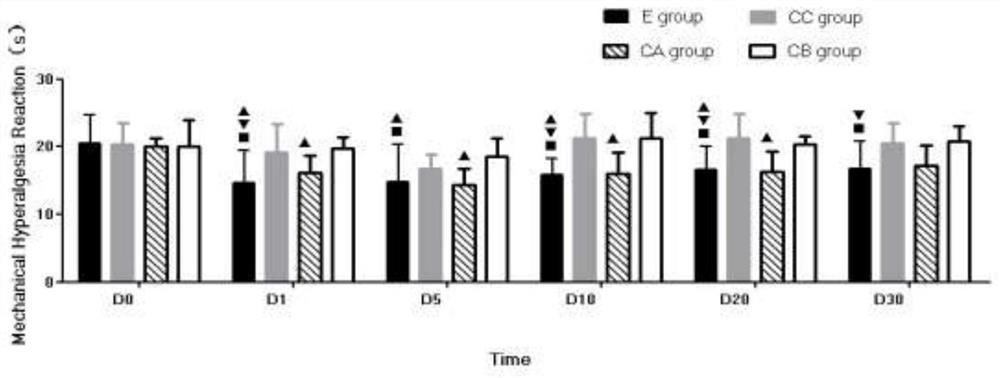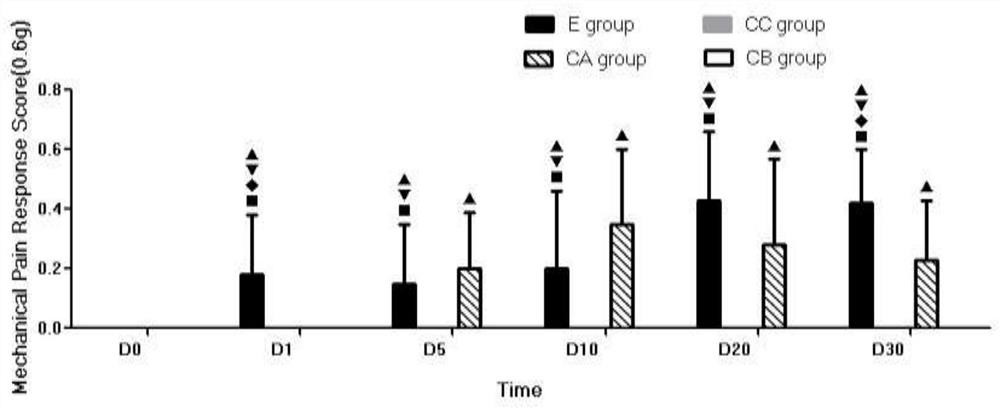Ventricular catheterization for constructing rat model for researching PHN pinecone excision and construction method thereof
A rat model and construction method technology, applied in veterinary instruments, veterinary surgery, medical science, etc., can solve the problems affecting the construction of rat models, large rat surgery, inconvenient operation, etc., to improve experimental accuracy and The effect of rat survival rate, reduction of catheter volume and improvement of survival rate
- Summary
- Abstract
- Description
- Claims
- Application Information
AI Technical Summary
Problems solved by technology
Method used
Image
Examples
Embodiment 2
[0064] Embodiment two is based on the structure of the ventricle catheter 1 in embodiment one to construct an animal model, and the specific content is as follows:
[0065] 1. Experimental animals
[0066] 88 healthy adult (3-month-old) male or female Wistar rats, each weighing about 200 g, were raised in an environment of 22° C., and provided with feed and drinking water normally. Rats were illuminated with a 40-watt daylight-colored fluorescent lamp, placed in a specially-designed, well-ventilated place, with a light-to-dark cycle ratio of 12h:12h, providing about 400 lux of energy. All the above operating procedures were approved by the Experimental Animal Protection and Use Committee of Guiyang Medical College.
[0067] 2. Build an animal model
[0068] S1, the prepared Wistar rats are randomly divided into non-treatment group (40) and treatment group (48);
[0069] S11, the non-treatment group rats in the step S1 are divided into four groups on average: A experimental ...
Embodiment 3
[0090] The third embodiment is described on the basis of the structure of the intraventricular catheter 1 in the first embodiment, and aims to clarify the method for measuring the mechanical pain threshold of rats.
[0091] The rats were placed on the mesh suspension board respectively, and after 20 minutes of acclimatization, the test probe was vertically applied 0.6g or 4.0g of mechanical stimulation to the hind feet for 5s. Rats were ranked according to their responses as follows: 0, no response; 1, away from the von Frey probe; 2, flinching or licking the hind paw. Each hind paw was stimulated with the same intensity after an interval of 3 minutes, and a total of 6 stimulations were given, and the average value was used as the pain-related score. In the experiment, when the Von Frey probe stimulated the rats, since it was difficult to distinguish the pain-related responses from the walking behavior, a pain-related score of 0.5 or higher could be regarded as hyperalgesia. ...
experiment example 4
[0093] Experimental Example 4 is described on the basis of the rat model constructed in Example 2, and aims to clarify the method for measuring the thermal paw withdrawal latency of rats.
[0094] The heat paw withdrawal latency of rats is measured by using an infrared heat radiation heat pain tester. The specific process is as follows: After the rat is placed in the experimental environment for 20 minutes, the hind paw is exposed to the light beam of the heat radiation heat pain tester. The average value of the measurements was used to determine the baseline latency, with a baseline of infrared intensity of radiant heat set to 1, about 20 seconds under normal conditions.
PUM
| Property | Measurement | Unit |
|---|---|---|
| Titer | aaaaa | aaaaa |
Abstract
Description
Claims
Application Information
 Login to View More
Login to View More - R&D
- Intellectual Property
- Life Sciences
- Materials
- Tech Scout
- Unparalleled Data Quality
- Higher Quality Content
- 60% Fewer Hallucinations
Browse by: Latest US Patents, China's latest patents, Technical Efficacy Thesaurus, Application Domain, Technology Topic, Popular Technical Reports.
© 2025 PatSnap. All rights reserved.Legal|Privacy policy|Modern Slavery Act Transparency Statement|Sitemap|About US| Contact US: help@patsnap.com



